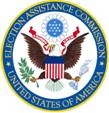Voting and Polling Place Accessibility
The Help America Vote Act and Voting System Guidelines
The Help America Vote Act of 2002 establishes requirements for voting systems used in Federal elections and contains key provisions on improving access to polling places and voting systems for persons with disabilities. Provisions in the law ensure that voting systems and polling places are accessible to people with disabilities, and also address ballot verification by voters, language barriers, and provisional voting.
The law requires every precinct in the country to have at least one voting machine or system accessible to persons with disabilities, including those with vision impairments, by January 1, 2006. Access is required so that persons with disabilities have the same opportunity for participation, including privacy and independence, afforded other voters.
 The Election Assistance Commission was established to implement the voting reforms of the act, including the development of new guidelines for voting systems. In December 2005, the Commission adopted the guidelines in final form. The Voluntary Voting System Guidelines cover usability, including accessibility for people with disabilities, security, and privacy. Access is addressed for all types of users, including those with vision impairments. The guidelines and other information related to the Help America Vote Act are available on the Commission's website. In addition to overseeing the development of these guidelines, the Commission serves as a national resource for information on the administration of Federal elections, conducts studies on voting system improvements, and administers various grant programs funded by the law.
The Election Assistance Commission was established to implement the voting reforms of the act, including the development of new guidelines for voting systems. In December 2005, the Commission adopted the guidelines in final form. The Voluntary Voting System Guidelines cover usability, including accessibility for people with disabilities, security, and privacy. Access is addressed for all types of users, including those with vision impairments. The guidelines and other information related to the Help America Vote Act are available on the Commission's website. In addition to overseeing the development of these guidelines, the Commission serves as a national resource for information on the administration of Federal elections, conducts studies on voting system improvements, and administers various grant programs funded by the law.
The law established several advisory bodies to assist the Commission in fulfilling its mission. The Access Board is represented on some of these panels, including the Technical Guidelines Development Committee, which drafted the new guidelines, and the Commission’s Board of Advisors. Through their seats on these entities, Access Board members J.R. Harding, Ed.D. and James Elekes, M.Ed, MPA/CPM helped enhance the guidelines’ coverage of accessibility. They submitted recommendations concerning the scope of the guidelines, the testing of voting system accessibility, and the process for amending the guidelines so that people with disabilities can vote in a manner that is convenient and private using systems that are reliably barrier-free.
FOR FURTHER INFORMATION CONTACT:
U.S. Election Assistance Commission
1225 New York Avenue, N.W., Suite 1100
Washington, D.C. 20005
(866) 747-1471
www.eac.gov
Voting Accessibility for the Elderly and Handicapped Act
An earlier law, the Voting Accessibility for the Elderly and Handicapped Act, also requires access
to polling places used in Federal elections. The law also requires States to
make available registration and voting aids, such as instructions in large type. If a State or political subdivision does not comply with this act, the U.S.
Attorney General or the person affected by the noncompliance may bring action
for relief in the appropriate district court. Complaints under this law can be filed with the U.S. Department of Justice.
FOR FURTHER INFORMATION CONTACT:
Voting Section,
Civil Rights Division
U.S. Department of Justice
Washington, DC 20035-6128
(800) 253-3931 (voice/TTY)
www.usdoj.gov/crt
 The Election Assistance Commission was established to implement the voting reforms of the act, including the development of new guidelines for voting systems. In December 2005, the Commission adopted the guidelines in final form. The Voluntary Voting System Guidelines cover usability, including accessibility for people with disabilities, security, and privacy. Access is addressed for all types of users, including those with vision impairments. The guidelines and other information related to the Help America Vote Act are available on the Commission's website. In addition to overseeing the development of these guidelines, the Commission serves as a national resource for information on the administration of Federal elections, conducts studies on voting system improvements, and administers various grant programs funded by the law.
The Election Assistance Commission was established to implement the voting reforms of the act, including the development of new guidelines for voting systems. In December 2005, the Commission adopted the guidelines in final form. The Voluntary Voting System Guidelines cover usability, including accessibility for people with disabilities, security, and privacy. Access is addressed for all types of users, including those with vision impairments. The guidelines and other information related to the Help America Vote Act are available on the Commission's website. In addition to overseeing the development of these guidelines, the Commission serves as a national resource for information on the administration of Federal elections, conducts studies on voting system improvements, and administers various grant programs funded by the law.